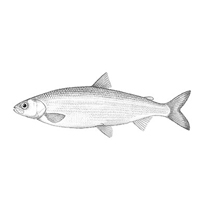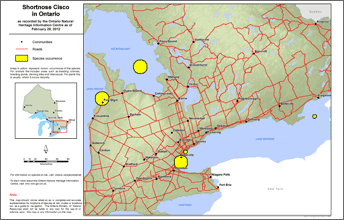Shortnose Cisco
Scientific name: Coregonus reighardi

Cover photo credit: Michigan Department of Natural Resources
Status
Endangered
“Endangered” means the species lives in the wild in Ontario but is facing imminent extinction or extirpation.
Date added to the Species at Risk in Ontario List
The Shortnose Cisco was already assessed as endangered when the Endangered Species Act took effect in 2008. A reassessment in November 2017 confirmed this status.
Read the assessment report (PDF).
What it looks like
The Shortnose Cisco is a member of the whitefish family.
It has a short head and snout, small eyes, and a tiny mouth. All of the fins are small compared to its somewhat stocky body, which usually grows to a length of 25 centimetres.
It has a yellow-green back, silver sides, and a white belly. The Shortnose Cisco can be distinguished from other cisco fish species by dark markings on the snout.
Where it lives
The Shortnose Cisco is found only in the Great Lakes of North America. It was last seen in Lake Ontario in 1964 and in Lake Huron in 1985.
Where it’s been found in Ontario
In Ontario, the Shortnose Cisco lives in the deep, cold water of the Great Lakes, usually at depths between 22 to 110 metres.
It has been found at depths reaching 144 metres! This species eats mostly freshwater shrimp.
View a Larger version of this map (PDF)
What threatens it
Ontario’s Shortnose Cisco population was greatly reduced by overfishing and possibly by competition or predation by exotic (non-native) species.
Action we are taking
Endangered species and their general habitat are automatically protected.
Recovery strategy
A recovery strategy advises the ministry on ways to ensure healthy numbers of the species return to Ontario.
Read the executive summary and the full document (December 7, 2018).
Government response statement
A government response statement outlines the actions the government intends to take or support to help recover the species.
Read the government response statement (September 5, 2019).
Review of progress
A review of progress made toward protecting and recovering a species is required no later than the time specified in the species’ government response statement, or not later than five years after the government response statement is published if no time is specified.
Read the report on progress towards the protection and recovery of 12 species at risk, including Shortnose Cisco (2024).
Habitat protection
General Habitat Protection - June 30, 2013
What you can do
Report a sighting
Report a sighting of an endangered animal or plant to the Natural Heritage Information Centre. Photographs with specific locations or mapping coordinates are always helpful.
Volunteer
Volunteer with your local nature club or provincial park to participate in surveys or stewardship work focused on species at risk.
Be a good steward
- Private land owners have a very important role to play in species recovery; if you find Shortnose Cisco in a watercourse on or adjacent to your property, you may be eligible for stewardship programs that support the protection and recovery of species at risk and their habitats
- Invasive species seriously threaten many of Ontario’s species at risk; to learn what you can do to help reduce the threat of invasive species, visit:
- Farmers and land owners can help improve fish habitat and keep Ontario’s water safe and clean by maintaining natural vegetation next to creeks and rivers, and keeping pollution and soil from washing into Ontario’s streams and rivers; for more information about programs and funding assistance for eligible land owners visit the Ontario Soil and Crop Improvement Association website
Report illegal activity
Report any illegal activity related to species at risk to
Quick facts
- The Shortnose Cisco, also called chub, was once commercially fished in the Great Lakes; in the late 1800s it was the main fish caught by Toronto fishing boats; by the 1930s this species was seldom caught and by the 1980s it had nearly disappeared.
- When the Shortnose Cisco was more common, it was probably an important food source for predators such as Lake Trout and Burbot.
- Shortnose Cisco is very difficult to distinguish from the other six species of ciscoes found in the Great Lakes, and experts often rely on the number and shape of the gill rakers (small bones along the gills) to help identify the species.
- Female Shortnose Ciscos have a longer lifespan than males, and can live up to 11 years.
- The Shortnose Cisco has not been reliably reported since 1985 and may be extinct.
